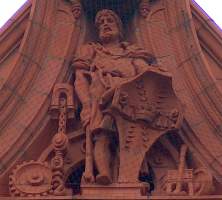
Allegorical statues emblematic of Industry are common across Britain, above all in the Victorian industrial cities and towns of the Midlands and North. Indeed, Industry occupies an elevated place in our pantheon or alphabet of allegorical statues as a defining characteristic of Victorian times, on a par with Art. Industry is usually a sturdy, muscular man, typically stripped to the waist and wearing the rough clothes of a worker. But where the composition demands a figure in classical dress, then normal drapery is found. Equally, there are a good number of female figures of Industry, often veering towards the muscular in arm and neck, or at least a liveliness and vigour of manner. We have the occasional youthful figure of Industry, typically in architectural settings where there is a requirement for all the figures to be of a type, as in the composition below, in Manchester, where pairs of boys flank the shield and eagle crest of an insurance company. Unlike many allegorical figures, it is very unusual to have an entirely unclothed figure of Industry, presumably as the risk of damage by the machines of industry to the naked body is too great – indicating a strong appreciation for Health and Safety among our enlightened Victorians…
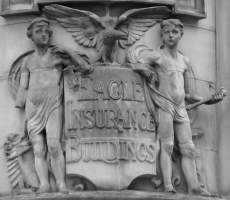 Manchester Eagle Star Industry figures.
Manchester Eagle Star Industry figures.
There are a variety of objects and accessories available to denote Industry, and our figures may have just one of these, or several. The commonest is the toothed gearwheel, closely followed by the anvil and the hammer. A beehive is not uncommon, or bees (for their industrious activity), and this emblem was particularly embraced by Manchester. Less common implements include heavy chains (see top of this page), or links from them, hooks or pulleys, girders, and spanners, steam engines, and smaller machines such as the spinning jenny, as well as other tools such as shovels and pliers, and manufactured products such as horse-shoes and bowls.
Industry group by P. R. Montford in
Cardiff, and Benjamin Creswick’s Birmingham coat of arms. 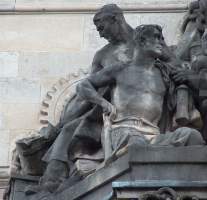
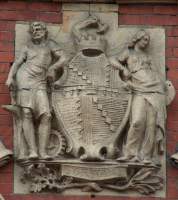
Female and male figures of Industry in Liverpool. 

Some figures of Industry may be easily mistaken for Engineering, and vice versa. The Albert Memorial has four Industries, of which Manufactures is the closest to Industry in the conventional sense, with a heavily-muscled workman resting on his hammer, classical female figures with a beehive and an hourglass, a youth, and a variety of other objects, including an an anvil, horseshoe, electroplated pots, and a massive clamp.
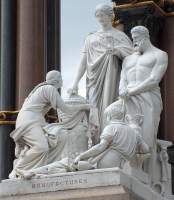 Group from London's Albert Memorial.
Group from London's Albert Memorial.
Of course sometimes a specific industry is depicted, but in such cases, the figures are generally pictorial rather than allegorical – as for example in these rather nice depictions of the Glassblowing Industry in Birmingham (see this page for more on this and neighbouring buildings) and steam-driven ore crushing in Leeds. Spinning is a counter-example, where an allegorical figure is common, as also shown below.
Two final examples, both from Manchester, are below. The one on the left, from the Manchester Free Trade Hall, by the always-interesting and extremely prolific John Thomas, has everything: the common gearwheel and anvil, a steam engine, press, mallet and shovels. The right-hand one is unusual in presenting a medieval Industry, very charming, with the implements drawn however more conventionally from the 19th century, including a little steam engine running up a steep viaduct in the background.
Back to Allegorical sculpture - H // Onwards to Allegorical sculpture - J // Full Alphabet of Allegorical sculpture
Sculpture in London // Sculpture in England // Sculptors
Visits to this page from 28 Dec 2011: 7,800